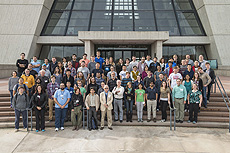Graduate students dig into neutrino-nucleus interactions at Fermilab
 |
| At the recent NuSTEC training at Fermilab, graduate students learn all about the subtleties of neutrino-nucleus interactions. Photo: Reidar Hahn |
What happens when a neutrino strikes a complex nucleus?
The answer is far from straightforward, even for particle physicists. It's also critical for carrying out neutrino experiments.
That's why MINERvA scientist Jorge Morfin of Fermilab proposed a special course for graduate students and postdocs to learn the nuts, bolts and subtleties of interactions between neutrinos and a nucleus made up of multiple protons and neutrons. Culminating months of organizing committee effort, the nine-day NuSTEC Training in Neutrino-Nucleus Scattering Physics, held at Fermilab, concluded on Wednesday.
"The concept of NuSTEC is to bring theorists and experimentalists from the nuclear and high-energy physics communities together to understand what's happening with neutrino-nucleus interactions," said Morfin, NuSTEC coordinator. "One of our first collaborative efforts was this NuSTEC training program."
Thanks to outstanding lecturers, it was a success. Eighty-five students, primarily experimentalists, gathered from around the world to learn how to parse these complicated interactions from theoretical nuclear physicists. Each day's talks were followed by an evening Q&A recitation session and a social hour where students continued to fire off questions to the instructors over food and drink.
The topic of neutrino-nucleus interactions, Morfin said, is specialized enough that students seldom learn about it in school but important enough that it merited a dedicated course.
"It's a good mixture of theorists and experimentalists. Having them all in one place means you get different perspectives that you wouldn't get from a straight lecture," said Sam Short of Queen Mary University of London. "There are loads of people to ask questions of."
And there are good reasons to ask the questions. As the world's neutrino oscillation experiments ramp up the number of neutrinos in their beams and build more sensitive detectors, scientists will be able to collect more and more precise data, reducing statistical errors. Understanding how neutrinos interact with the nuclei in the detector material will help further reduce errors and lead to neutrino oscillation measurements of unprecedented precision.
That kind of precision is crucial for a project such as the proposed Long-Baseline Neutrino Facility hosted by Fermilab, where neutrino oscillation effects are to be measured to order percent accuracy.
"If you go to a conference, you only see the science results, but here they show you how the detectors come into play," said Tom Van Cuyck, a theoretical physics student at the University of Ghent in Belgium. "It's interesting to learn something beyond your field."
The training received monetary support from DOE, NSF, Fermilab, Jefferson Lab and the Center for Neutrino Physics at Virginia Tech University.
—Leah Hesla
|